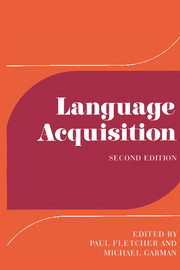Book contents
- Frontmatter
- Contents
- Contributors
- Preface
- Part I Contexts and determinants
- Part II The development of linguistic systems: phonology
- Introduction
- 7 Prespeech segmental feature development
- 8 Prosodic development
- 9 Early strategies for the perception and production of words and sounds
- 10 Phonological development: production
- 11 Speech perception and the emergent lexicon: an ethological approach
- 12 Phonological development: a crosslinguistic perspective
- Part III The development of linguistic systems: grammar
- Part IV Later language development
- Notes to chapters
- Bibliography and citation index
- General index
- Titles in the series
9 - Early strategies for the perception and production of words and sounds
Published online by Cambridge University Press: 05 June 2012
- Frontmatter
- Contents
- Contributors
- Preface
- Part I Contexts and determinants
- Part II The development of linguistic systems: phonology
- Introduction
- 7 Prespeech segmental feature development
- 8 Prosodic development
- 9 Early strategies for the perception and production of words and sounds
- 10 Phonological development: production
- 11 Speech perception and the emergent lexicon: an ethological approach
- 12 Phonological development: a crosslinguistic perspective
- Part III The development of linguistic systems: grammar
- Part IV Later language development
- Notes to chapters
- Bibliography and citation index
- General index
- Titles in the series
Summary
Introduction
Not until this past decade has the notion of the development of perceptual and productive phonemic contrasts during the so-called ‘prelinguistic’ period been taken seriously by linguists. Previously it was held that during this period infants engaged in playful sound making. The sounds produced were held to be largely a product of the random exercise of the human infant's vocal mechanism for sound making, and, therefore, the sounds produced were universal. Further, Jakobson (1968) suggested that there was a silent period between the production of babbled utterances and the production of first words. This silent period indicated the discontinuity between the two periods. Some behaviourist researchers, in contrast to this, suggested that this prelinguistic period was one during which the child's perception and production of sound contrasts was ‘shaped’ by parental input to take on gradually the characteristics of the adult's perception and production of sounds in the native language. This shaping occurred through the principles of conditioning (i.e. observing stimulus–response–reward relations). These sound generalizations were then chunked into words and the words into sentences. The most perceptually salient sounds were those mastered earliest. Therefore, no discontinuity could be said to exist between so-called prelinguistic and linguistic behaviour (Olmsted 1966; Staats 1967).
Recent data on the discrimination and production of speech sound contrasts by infants, that both these positions are questionable (Ferguson 1976).
- Type
- Chapter
- Information
- Language AcquisitionStudies in First Language Development, pp. 198 - 222Publisher: Cambridge University PressPrint publication year: 1986
- 19
- Cited by



